How To Repair Wood Scupltured Table
Home > Customer Projects > Wooden Bear Carving Repair
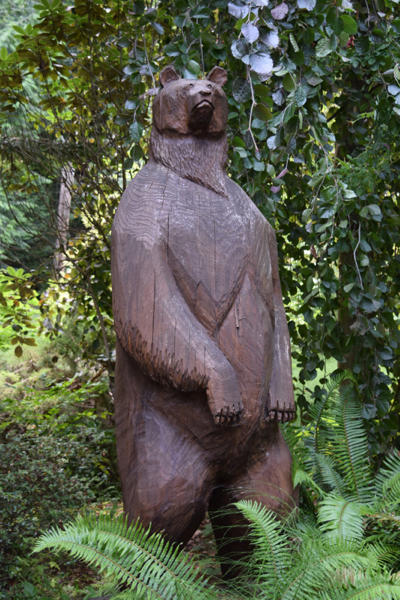

Discipline: Wooden Acquit Etching Repair
Appointment: Aug 2022 – May 2022
Note: All images can be seen in a larger version by clicking on them.
Information technology doesn't happen often, but once in a blue moon, nosotros get the opportunity to help our customers with their projects in a more hands-on way. And this is such a projection. It is a six pes-plus alpine wooden comport, carved with a chainsaw, out of a expressionless tree, stump still in the ground.
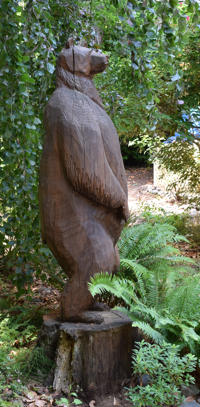
Unfortunately, the stump still beingness in the ground allowed moisture, and especially carpenter ants, to damage the bear carving. The pictures they showed united states of america indicated that it was likely an extensive repair. Since the acquit was within piece of cake driving altitude, we agreed to go see the sculpture in person, and appraise the extent of the damage.
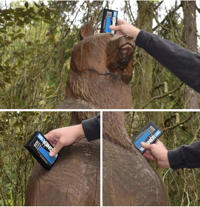
With a RF moisture meter and a visual inspection, it was credible that the harm was adequately all-encompassing. And while it would exist possible to repair the harm in place, information technology would certainly be easier to do with the bear down off the stump. Removing the comport from the stump as well immune for the stump to be removed, and replaced with something more permanent. Considering of the extensive nature of the damage, we decided that this was non a job for someone with no experience in using our products to try and tackle. So nosotros agreed to practise the repair for the client. While that is fine in theory, this left actually doing the job.
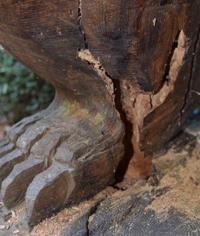
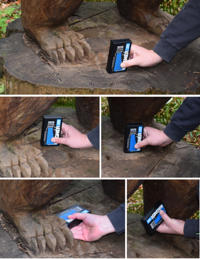
Ants had clearly washed significant impairment to the left leg of the bear. Further inspection showed that they were living throughout the trunk of the bear equally well.
In improver to the ant problem, there was also the effect of wet. In our preliminary examination, the stump, feet, and middle of the head showed loftier moisture content, when surveyed with a professional person grade Wagner moisture meter.
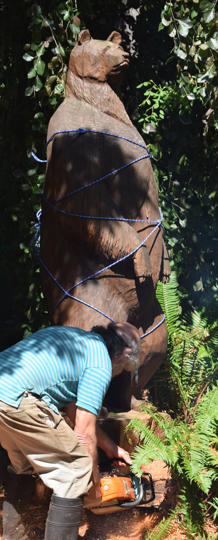
The nearly hard role of the job was getting the bear down off the stump, and then dorsum, once a suitable base had been procured. A six pes wooden acquit is non lite. Our estimate is 300–400 pounds. After much word, and a prohibitively expensive quote from a professional company, we decided to tackle this job ourselves, even though none of united states of america had whatsoever experience in doing something like this.
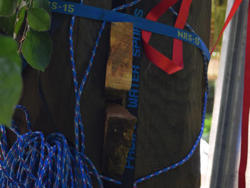
The owners rented a portable elevator, and after rigging a harness, and cutting the base with a chainsaw, the bear was put onto sawhorses. Notation: with a meaning crack down her backside, we added wedges to keep any pressure around her torso from splitting her apart during the motility off of the stump.
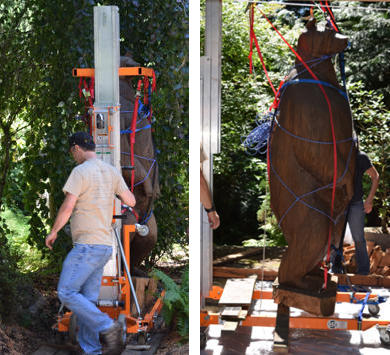
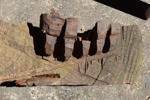
Although it all went as planned, except the conduct'due south toes bankrupt off 1 foot, we weren't likewise concerned. We knew that the epoxies we would be using would easily re-adhere the toes. Everyone was much relieved to have her resting on the sawhorses.
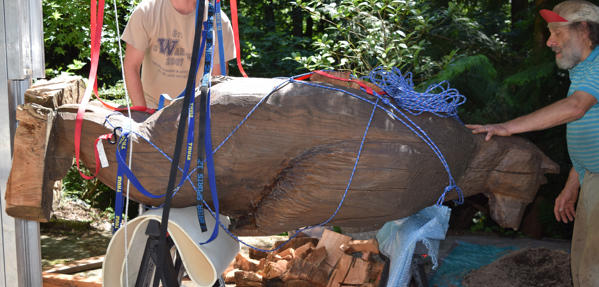
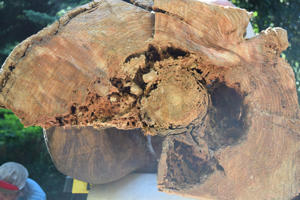
The carpenter ants had severely hollowed one leg, and were living throughout the body. The other leg showed some signs of pismire damage, simply was not nearly as damaged. And, while it wasn't axiomatic from the surface, the ants had made nesting cavities up through the torso, all the way to the head.
While the moisture didn't seem to be causing much damage, it did however hinder the repair, equally moist woods doesn't blot epoxies, even good quality penetrating epoxies like the S-1 Sealer, nearly as well as dry out wood.
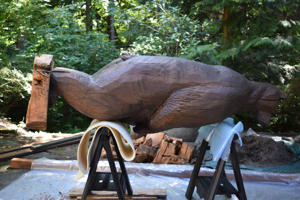
Once we had the bear on the "operating table", repairs could commence. While the preferred strategy is to remove 95 percent of the damaged textile, then beginning applying the epoxy products. In this case, that was not desirable, as we wanted to preserve as much of the original structure as possible, while disturbing the outer appearance as piddling as nosotros could get away with. And then we decided to utilise an arroyo that is mutual with log abode repair, the drill and fill up method. While this method can be just as effective as any other, it does usually take longer, and more care should be taken that a thorough repair is washed.
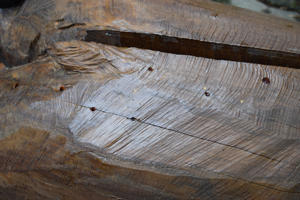
Starting at the more damaged leg, holes were drilled approximately every 4–6 inches (x–15 cm), as far every bit the damage was encountered. Which, in this case, was the caput. Holes were also drilled in the reverse side, but no significant impairment was institute. The holes were limited to the back, to limit the cosmetic harm.
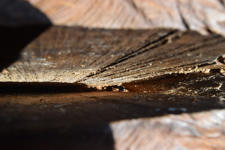
Upon drilling the holes, the tailings were found to be quite moisture, which was to exist expected. There are several ways to dry out out wet wood. Drilling holes, and letting things air dry, pouring isopropyl alcohol or acetone into the holes, or putting the material under a vacuum. This last method is the most constructive, but the almost expensive and troublesome to execute. Flooding the wood with acetone is the second most effective method, and much easier that pulling a vacuum. So acetone was poured into the drill holes and along the crack down her back. Since the moisture was within of good wood, several weeks were needed for most of the acetone to gas off, bringing much of the moisture with it.
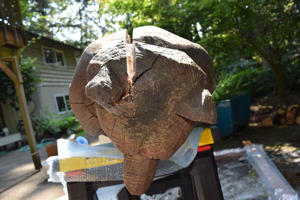
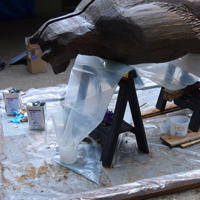
Once the wood was dry plenty, it was time to starting time applying products. Kickoff up was the S-1 Sealer. This is a ii part epoxy, but composite with solvents to allow it to penetrate any porous material such as deteriorated woods. It was applied until the wood stopped absorbing whatever more. The S-i Sealer was applied non but into the holes that were drilled into the body but into the crack that ran down the dorsum. Whatsoever backlog that came out was captured and reapplied. Every bit with the acetone, enough time needed to laissez passer for the solvents to evaporate. In about cases, i to two days is sufficient. In this case, another two weeks was deemed enough.
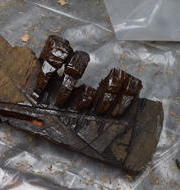
South-1 Sealer was used to treat the inside of the hollowed out leg and both the feet. At the aforementioned time nosotros also treated the toes that were "removed" for future replacement with the S-one Sealer.
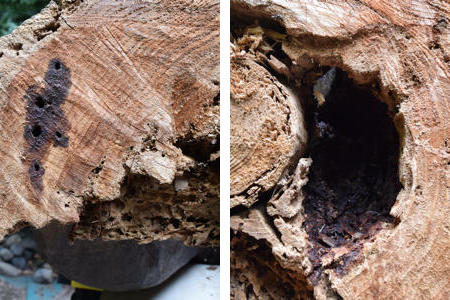
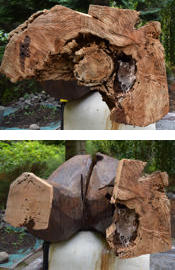
Once the Southward-i was allowed to cure the excess forest from the base was removed in sections over fourth dimension. The SculpWood Epoxy Paste was used before the General Purpose Epoxy Resin on the inside the bad leg to fill the holes made past the ants. This was done so that the General Purpose Epoxy Resin would non flow back out these holes equally we filled the emmet cavities from the drill holes nosotros fabricated.
There are several choices when information technology comes to fillers. Which is best actually depends on what and how you are filling. In this case, we needed something that would ooze and settle into a contained surface area. So there was only 1 expert selection General Purpose (GP) Epoxy Resin. Poured into the drill holes, it flowed and settled into every nook and cranny. It fifty-fifty managed to find the smallest cracks and pinholes through to the exterior, which caused leaks. Several times we had to use tape, sometimes with plastic-insulated rags to stop the leak until the epoxy had a gamble to cure. While bothersome, it is nice to know that the resin was able to reach the smallest cavities.
While GP Epoxy Resin was used to fill near of the voids, it wasn't the only product used. Sculpwood Epoxy Paste, either straight, or mixed with sawdust, was used when a thicker product was needed. For fill that was going to be seen on the surface, dark-brown resin dye was added to the mix.
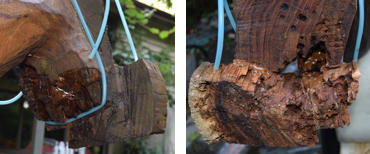
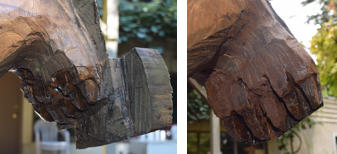
The foot and it's missing toes were treated with the South-1 Sealer earlier. Once cured, the toes were glued back into place with colored SculpWood Epoxy Paste. The colored SculpWood Epoxy Paste was too used as the finishing make full where at that place was some missing wood. The SculpWood Epoxy Paste was used to fill almost of the open cavity in the leg as well, this was done in stages. Duct tape was used equally a backing to fill against in the gap in the pismire damaged leg. Filling of the bottoms of the feet and the leg continued to exist done with the Paste and in places where the tape alone could not hold the shape, rags were used to give the desired shape.
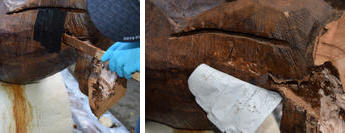
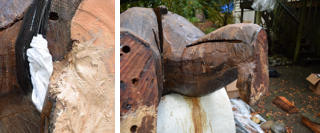

The GP Epoxy Resin was used to fill in from the meridian of the leg cavity, (this was done from the actress chainsaw mark left open) again done in stages so that it would be allowed to "percolate" into all the unfilled nooks and crannies.
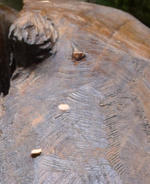
Once the internal cavities were filled, nosotros needed to stop off the drill holes. To get the best expect, chip pieces of woods from the stump were carved into plugs, with the grain oriented in the aforementioned direction as the bear. These were glued in, and sawed flush, giving the surface the ability to accept the stain preservative that had been used previously. This made the drill holes nearly invisible.
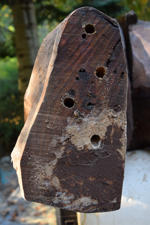
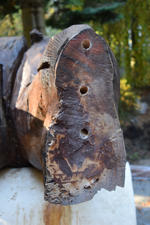
Later careful consideration, the decision was fabricated to put the deport back on a concrete pedestal. And to use several pieces of stainless threaded rod in each leg to mount her into the concrete. Suspended over the form during the concrete pour seemed the easiest way to get her aligned properly while the concrete set. Three foot long, 5/8ths inch stainless rod was used, glued in place after holes were drilled into the repaired legs. 3/4 inch washers were added to provide maximum anchoring to the concrete.
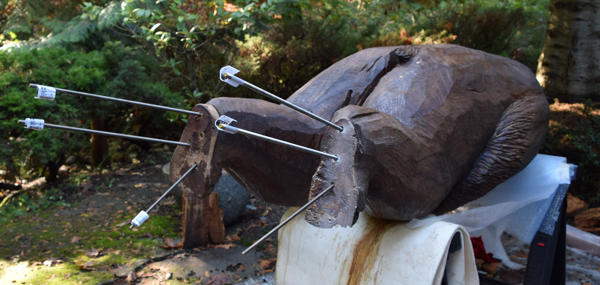
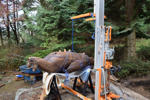
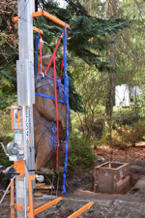
A few days before the physical was to be poured, the lift was rented, a harness was rigged, and straps were used to lift the the bear upright. After careful tweaking of the position, she was left hanging until cascade day. There were a couple of terminal infinitesimal things that needed to be done to the course, and then nosotros couldn't put the bear over the form alee of time. We had to wait until the bodily day of the pour to get the bear moved over the class. The concrete people wanted to pour the concrete first, and then sink the rods down in. On our first attempt, we were not able to get the rods to sink all the way downward. And so she was lifted upwardly, and the washers were removed. Apparently they were catching on the steel reinforcing, or just providing enough resistance to the concrete itself. Fortunately, the rods, with no washers, were able to sink down into the concrete. Just. She got low-cal on the lift as her feet approached to height of the form. After putting her weight back onto the straps, and checking the alignment, she was left in identify while the concrete cured.
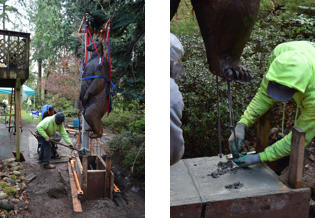
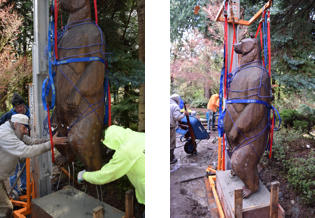
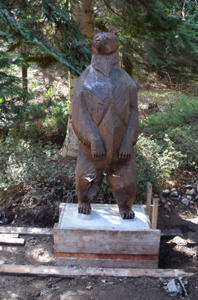
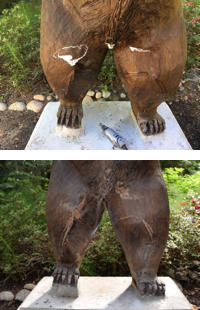
Fortunately, everything went every bit intended. The whole project ended upwards beingness a great success. All that remained was cosmetic work, cleaning up the backlog epoxy that is on the surface too as some of the padding that was glued to the surface. Since moisture tin can't wick up through the base of operations any more, the original problem was eliminated.
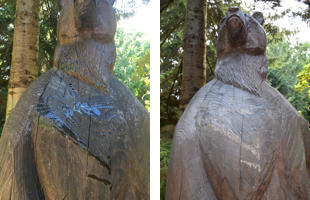
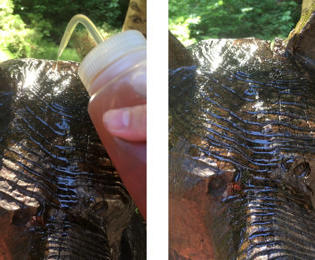


While the main damage was from carpenter ants through the feet, there was some moisture at the acme of the head besides. Any cracks in the top of the caput were well treated with S-1 Sealer to reduce or eliminate the ability of moisture to become into the wood. That, and a regular application of the original treatment should proceed the bear rot free, and looking good for many years to come.
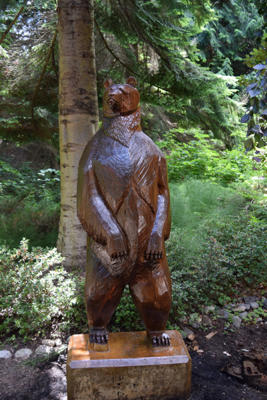
A fresh coat of finish and she's ready for whatever comes next!
We have included some close-ups of the repairs, the drill holes are barely visible. And you tin can not tell that the toes were one time no longer part of her pes.
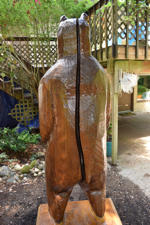
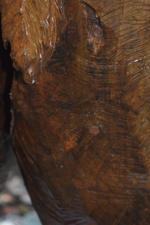
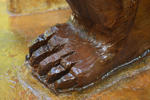
Have questions?
Contact usa past phone 206-364-2155 or e-mail (send us your pictures) at drrot@rotdoctor.com and we will gladly answer questions well-nigh our products or how to use them. With twenty+ years of experience and many more in the boating and construction industries, non much surprises us. We are here to aid our customers solve their issues. Let us help you to not have any surprises in your repair projection.
Source: https://www.rotdoctor.com/projects/bear.html
Posted by: ervingdiesse.blogspot.com


0 Response to "How To Repair Wood Scupltured Table"
Post a Comment